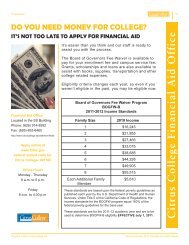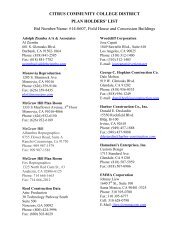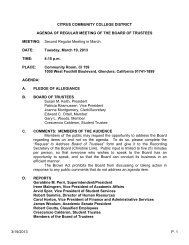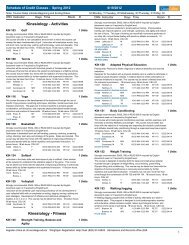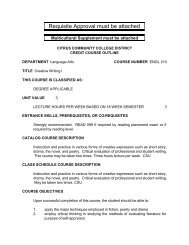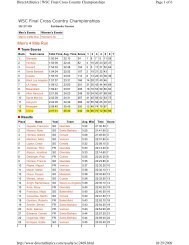Bid #01-1112 Library and Reprographics Roofing ... - Citrus College
Bid #01-1112 Library and Reprographics Roofing ... - Citrus College
Bid #01-1112 Library and Reprographics Roofing ... - Citrus College
You also want an ePaper? Increase the reach of your titles
YUMPU automatically turns print PDFs into web optimized ePapers that Google loves.
Form W-9 (Rev. 10-2007)<br />
Generally, individuals (including sole proprietors) are not exempt<br />
from backup withholding. Corporations are exempt from backup<br />
withholding for certain payments, such as interest <strong>and</strong> dividends.<br />
Note. If you are exempt from backup withholding, you should<br />
still complete this form to avoid possible erroneous backup<br />
withholding.<br />
The following payees are exempt from backup withholding:<br />
1. An organization exempt from tax under section 501(a), any<br />
IRA, or a custodial account under section 403(b)(7) if the account<br />
satisfies the requirements of section 401(f)(2),<br />
2. The United States or any of its agencies or<br />
instrumentalities,<br />
3. A state, the District of Columbia, a possession of the United<br />
States, or any of their political subdivisions or instrumentalities,<br />
4. A foreign government or any of its political subdivisions,<br />
agencies, or instrumentalities, or<br />
5. An international organization or any of its agencies or<br />
instrumentalities.<br />
Other payees that may be exempt from backup withholding<br />
include:<br />
6. A corporation,<br />
7. A foreign central bank of issue,<br />
8. A dealer in securities or commodities required to register in<br />
the United States, the District of Columbia, or a possession of<br />
the United States,<br />
9. A futures commission merchant registered with the<br />
Commodity Futures Trading Commission,<br />
10. A real estate investment trust,<br />
11. An entity registered at all times during the tax year under<br />
the Investment Company Act of 1940,<br />
12. A common trust fund operated by a bank under section<br />
584(a),<br />
13. A financial institution,<br />
14. A middleman known in the investment community as a<br />
nominee or custodian, or<br />
15. A trust exempt from tax under section 664 or described in<br />
section 4947.<br />
The chart below shows types of payments that may be<br />
exempt from backup withholding. The chart applies to the<br />
exempt payees listed above, 1 through 15.<br />
IF the payment is for . . .<br />
Interest <strong>and</strong> dividend payments<br />
Broker transactions<br />
Barter exchange transactions<br />
<strong>and</strong> patronage dividends<br />
Payments over $600 required<br />
to be reported <strong>and</strong> direct<br />
1<br />
sales over $5,000<br />
1<br />
THEN the payment is exempt<br />
for . . .<br />
All exempt payees except<br />
for 9<br />
Exempt payees 1 through 13.<br />
Also, a person registered under<br />
the Investment Advisers Act of<br />
1940 who regularly acts as a<br />
broker<br />
Exempt payees 1 through 5<br />
Generally, exempt payees<br />
2<br />
1 through 7<br />
See Form 1099-MISC, Miscellaneous Income, <strong>and</strong> its instructions.<br />
2<br />
However, the following payments made to a corporation (including gross<br />
proceeds paid to an attorney under section 6045(f), even if the attorney is a<br />
corporation) <strong>and</strong> reportable on Form 1099-MISC are not exempt from<br />
backup withholding: medical <strong>and</strong> health care payments, attorneys’ fees, <strong>and</strong><br />
payments for services paid by a federal executive agency.<br />
Part I. Taxpayer Identification<br />
Number (TIN)<br />
Page 3<br />
Enter your TIN in the appropriate box. If you are a resident<br />
alien <strong>and</strong> you do not have <strong>and</strong> are not eligible to get an SSN,<br />
your TIN is your IRS individual taxpayer identification number<br />
(ITIN). Enter it in the social security number box. If you do not<br />
have an ITIN, see How to get a TIN below.<br />
If you are a sole proprietor <strong>and</strong> you have an EIN, you may<br />
enter either your SSN or EIN. However, the IRS prefers that you<br />
use your SSN.<br />
If you are a single-member LLC that is disregarded as an<br />
entity separate from its owner (see Limited liability company<br />
(LLC) on page 2), enter the owner’s SSN (or EIN, if the owner<br />
has one). Do not enter the disregarded entity’s EIN. If the LLC is<br />
classified as a corporation or partnership, enter the entity’s EIN.<br />
Note. See the chart on page 4 for further clarification of name<br />
<strong>and</strong> TIN combinations.<br />
How to get a TIN. If you do not have a TIN, apply for one<br />
immediately. To apply for an SSN, get Form SS-5, Application<br />
for a Social Security Card, from your local Social Security<br />
Administration office or get this form online at www.ssa.gov. You<br />
may also get this form by calling 1-800-772-1213. Use Form<br />
W-7, Application for IRS Individual Taxpayer Identification<br />
Number, to apply for an ITIN, or Form SS-4, Application for<br />
Employer Identification Number, to apply for an EIN. You can<br />
apply for an EIN online by accessing the IRS website at<br />
www.irs.gov/businesses <strong>and</strong> clicking on Employer Identification<br />
Number (EIN) under Starting a Business. You can get Forms W-7<br />
<strong>and</strong> SS-4 from the IRS by visiting www.irs.gov or by calling<br />
1-800-TAX-FORM (1-800-829-3676).<br />
If you are asked to complete Form W-9 but do not have a TIN,<br />
write “Applied For” in the space for the TIN, sign <strong>and</strong> date the<br />
form, <strong>and</strong> give it to the requester. For interest <strong>and</strong> dividend<br />
payments, <strong>and</strong> certain payments made with respect to readily<br />
tradable instruments, generally you will have 60 days to get a<br />
TIN <strong>and</strong> give it to the requester before you are subject to backup<br />
withholding on payments. The 60-day rule does not apply to<br />
other types of payments. You will be subject to backup<br />
withholding on all such payments until you provide your TIN to<br />
the requester.<br />
Note. Entering “Applied For” means that you have already<br />
applied for a TIN or that you intend to apply for one soon.<br />
Caution: A disregarded domestic entity that has a foreign owner<br />
must use the appropriate Form W-8.<br />
Part II. Certification<br />
To establish to the withholding agent that you are a U.S. person,<br />
or resident alien, sign Form W-9. You may be requested to sign<br />
by the withholding agent even if items 1, 4, <strong>and</strong> 5 below indicate<br />
otherwise.<br />
For a joint account, only the person whose TIN is shown in<br />
Part I should sign (when required). Exempt payees, see Exempt<br />
Payee on page 2.<br />
Signature requirements. Complete the certification as indicated<br />
in 1 through 5 below.<br />
1. Interest, dividend, <strong>and</strong> barter exchange accounts<br />
opened before 1984 <strong>and</strong> broker accounts considered active<br />
during 1983. You must give your correct TIN, but you do not<br />
have to sign the certification.<br />
2. Interest, dividend, broker, <strong>and</strong> barter exchange<br />
accounts opened after 1983 <strong>and</strong> broker accounts considered<br />
inactive during 1983. You must sign the certification or backup<br />
withholding will apply. If you are subject to backup withholding<br />
<strong>and</strong> you are merely providing your correct TIN to the requester,<br />
you must cross out item 2 in the certification before signing the<br />
form.



